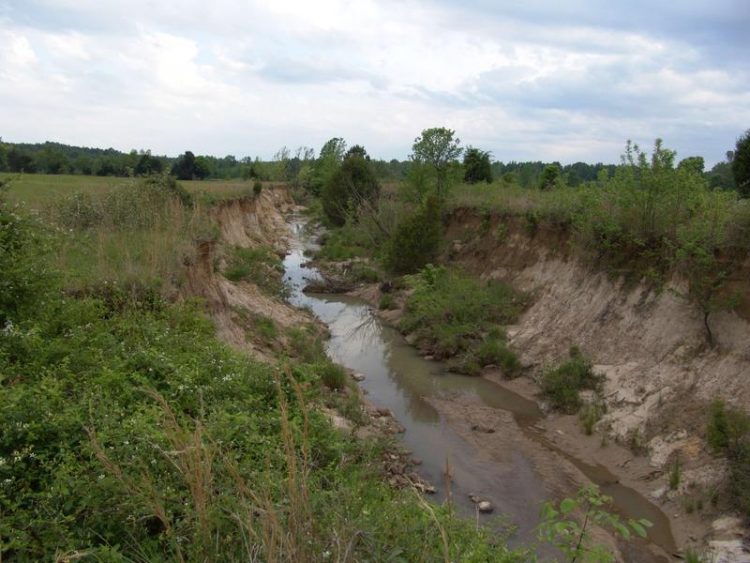Agricultural insecticide contamination threatens U.S. surface water integrity at the national scale

Degraded agricultural stream in the Mississippi delta. Ralf Schulz
Insecticides are applied in large volumes across the United States to protect agricultural crops from insect pests. As has been shown before through studies e.g. by the USGS or the U.S. EPA, these substances can be transported from agricultural fields into adjacent water bodies via various pathways where they have profound adverse effects on both water quality and biodiversity.
Therefore, insecticides have to pass an elaborated environmental risk assessment procedure before being sold and applied to crops. During this process, regulatory threshold concentrations are derived, which should not be surpassed, in order to prevent adverse effects in non-target environments such as surface waters.
These thresholds were compared to actual field concentrations of 32 commonly applied insecticides, obtained from 259 peer-reviewed publications reporting insecticide concentrations in more than 600 water bodies in the U.S.
In this extensive meta-analysis, about half of the total of 5817 measured insecticide concentrations exceeded these critical thresholds; more so, about one fourth of all concentrations surpassed these thresholds by a factor of ten or more.
Thus insecticides occur frequently at adverse concentrations and exceed levels that were expected during the pesticides’ approval process. In addition, risks were even more pronounced for smaller water bodies, which is especially concerning considering that they denote critical habitats for endangered species and serve as important spawning grounds for fish.
In particular newer insecticides, such as pyrethroids and neonicotinoids, were of particular concern, replacing older substances but thereby failing to provide a more environmentally safe alternative.
“One of our biggest concerns is that environmental risks did not decrease over time.”, added Jakob Wolfram. As a result, insecticides’ current use practices may not be in accordance with environmental protection goals, requiring a critical reassessment of their environmental risks.
In the future, insecticide application may even increase due to changing weather conditions and intensifying pressure from invasive pest species. Addressing this central challenge to surface water integrity appears thus more pressing than ever, if sustainable and safe use of water resources should be achieved in the United States.
University of Koblenz-Landau
Department of Environmental Sciences
Prof. Dr. Ralf Schulz
Fortstraße 7
D-76829 Landau
Phone: +49 6341 280-31327
Email: schulz@uni-landau.de
“Meta-Analysis of Insecticides in United States Surface Waters: Status and Future Implications” by Jakob Wolfram, Sebastian Stehle, Sascha Bub, Lara L. Petschick, Ralf Schulz. The study was published on November 26, 2018 in the journal Environmental Science & Technology.
Media Contact
More Information:
http://www.uni-koblenz-landau.deAll latest news from the category: Power and Electrical Engineering
This topic covers issues related to energy generation, conversion, transportation and consumption and how the industry is addressing the challenge of energy efficiency in general.
innovations-report provides in-depth and informative reports and articles on subjects ranging from wind energy, fuel cell technology, solar energy, geothermal energy, petroleum, gas, nuclear engineering, alternative energy and energy efficiency to fusion, hydrogen and superconductor technologies.
Newest articles

A universal framework for spatial biology
SpatialData is a freely accessible tool to unify and integrate data from different omics technologies accounting for spatial information, which can provide holistic insights into health and disease. Biological processes…

How complex biological processes arise
A $20 million grant from the U.S. National Science Foundation (NSF) will support the establishment and operation of the National Synthesis Center for Emergence in the Molecular and Cellular Sciences (NCEMS) at…

Airborne single-photon lidar system achieves high-resolution 3D imaging
Compact, low-power system opens doors for photon-efficient drone and satellite-based environmental monitoring and mapping. Researchers have developed a compact and lightweight single-photon airborne lidar system that can acquire high-resolution 3D…





















